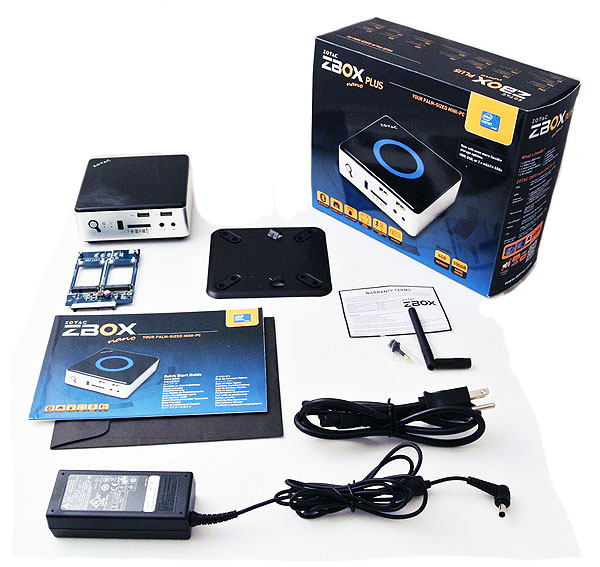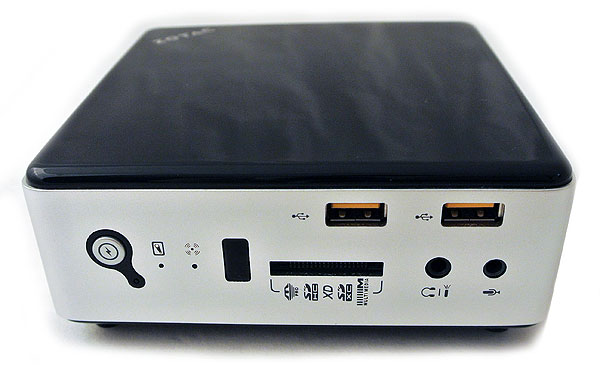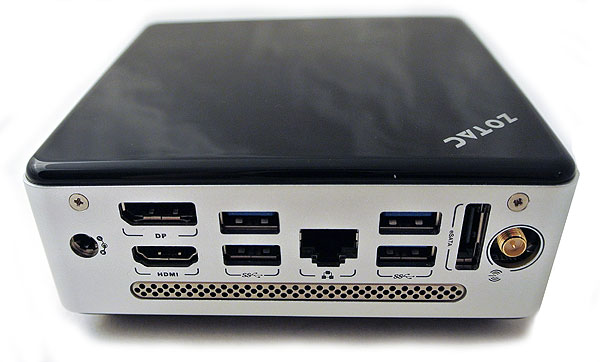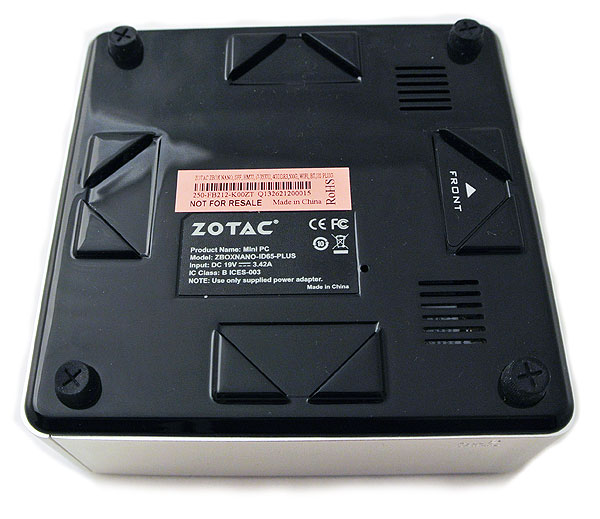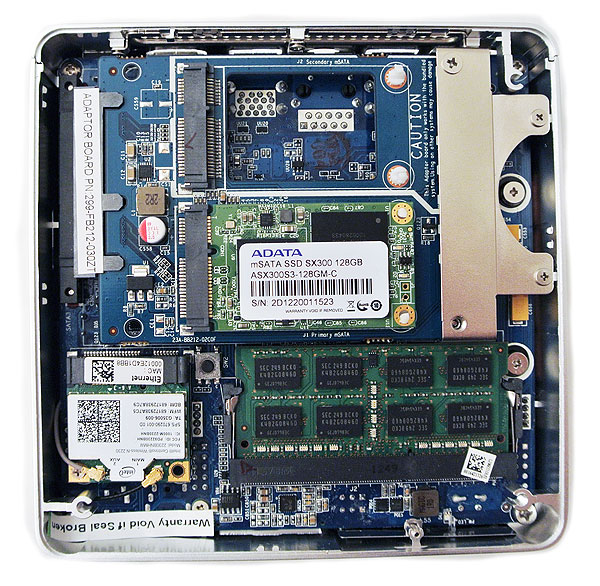Seven Small (But Powerful) Mini-PCs, Reviewed
Zotac Zbox Nano ID65 Plus
Why you can trust Tom's Hardware
Zotac was in the mini-PC business long before Intel joined the party. Its Zbox line-up emerged back in 2010, and the ultra-compact Zbox nano form factor surfaced in 2011. Armed with an anemic AMD E-350 APU, integrated Radeon HD 6310 graphics, 2 GB of RAM, and a 320 GB hard drive, the 5" x 5" x 1.8" AD10 beat Intel's option to market by a year and a half. The NUC looks awfully similar, doesn't it? Just look at how far we've come performance-wise.
Compelled by the thermal ceiling of Intel's low-voltage Ivy Bridge-based CPUs, Zotac squeezed much more powerful hardware into the nano's chassis, yielding the ID65 Plus. It comes equipped with a Core i7-3537U processor sporting a 2 GHz base clock, 3.1 GHz peak Turbo Boost frequency, and 4 MB shared L3 cache.
Intel's HD Graphics 4000 is perhaps the platform's weakest link. To be fair to Zotac, this isn't a new product; it was introduced earlier in 2013. We chose it to serve as the heart of an upcoming automotive build project, though, and thought it deserved an opportunity to participate in today's round-up. The good news is that Zotac's Haswell-equipped replacement, the nano ID68 plus, should show up in the U.S. very soon. It sports a Core i5-4200U CPU with Intel HD 4600 graphics in the exact same chassis as the ID65 we're looking at today.
Fortunately, a mature market means that the Zbox nano ID65 Plus sells for under $550 on Amazon. It's not a stripped-down barebones system, either. Rather, it includes a 500 GB hard drive, 4 GB of DDR3-1600, and a Wi-Fi/Bluetooth card. Buy an operating system and hook up some peripherals and you're good to go. We settled on a $730 price tag with Windows 8.1 Professional.
Bundle And First Impression
Inside Zotac's packaging you'll find the Zbox nano itself, a VESA mounting plate, documentation, a driver CD, a wireless antenna, an AC adapter, power cord, and an S/PDIF-to-optical adapter. The system comes equipped with a 2.5" mechanical hard drive, but a SATA-to-dual-mSATA adapter is included too. This component is unique among the mini-PCs we're testing; it lets you add two mSATA-based drives and rope them together in a RAID array if you wish.
It's tempting to say the Zbox nano looks like a slightly larger NUC, given 5" x 5" x 1.8" measurements. But Zotac's form factor came first, so it's probably more accurate to say Intel's design takes after the Zbox. Compact size aside, you still get the signature power ring up top that lights up when the small system is on. It looks great in blue, just as it did in green on the original Zbox nano AD10.
A quick comparison shows that Intel's Haswell-based NUC is 4.6" x 4.4" x 1.4". So, while the Zbox is larger, the extra volume isn't going to make a ton of difference on your desktop or mounted to the back of your monitor. Zotac's solution is also about 12% heavier than Intel's revised platform.
Right up front, Zotac gives you an IR receiver, a memory card reader, two USB 2.0 ports, and two audio jacks. The microphone jack doubles as an S/PDIF output, which is compatible with the bundled S/PDIF-to-optical adapter.
Around back we find full-sized DisplayPort and HDMI outputs, four USB 3.0 ports, GbE connectivity, eSATA, AC power input, and an interface for the included Wi-Fi antenna. This is the only contender in our story leaning on an external antenna.
The bottom access plate is removable without a screwdriver; the large rubber feet are easily turned by hand. Only three of the four feet actually hold the Zbox's cover in place.
The insides are completely unique from Intel's NUC or Gigabyte's Brix. I removed the 500 GB Samsung Spinpoint M8 disk drive and installed the dual-mSATA adapter for my picture. Really, the only disappointment is a single-channel memory architecture, which fails to fully utilize the Ivy Bridge controller. Most of our compute-intensive workloads aren't negatively affected, but a lack of bandwidth does hit graphics performance. At any rate, there's a 4 GB DDR3-1600 SO-DIMM already installed, along with an Intel Centrino 2230 802.11n/Bluetooth 4.0 wireless card.
Special Features And Livability
Less-compact dimensions compared to the NUC don't really bother me in a desktop environment. I'm more focused on the possibilities enabled by the Zbox nano's extra space inside. Do you want a 2.5" hard disk in a tiny PC? Do you want an mSATA-based RAID setup? Do you want to use both input and output audio jacks at the same time? How about an integrated memory card reader? Intel recently updated its NUC family with two models that are a little thicker and do accommodate 2.5" drives, but lack some of the other features.
I was intrigued with what the original Zbox nano offered back in 2011, but never fully appreciated Zotac's work until I worked on this comparison and dealt with the competition's limitations. Again, though, a lack of dual-channel memory support hurts an otherwise command performance. It's unfortunate that the Haswell-based models won't fix this.
| Header Cell - Column 0 | Zotac Zbox Nano ID65 Plus |
|---|---|
| Chipset | Intel HM77 Express |
| CPU | Intel Core i7-3537U, Dual-Core, Hyper-Threaded, 2 GHz (3.1 GHz Peak Turbo Boost), 4 MB Shared L3 Cache |
| Graphics | Intel HD Graphics 4000, 350 MHz - 1.2 GHz |
| Graphics Memory | Shared with system memory |
| System Memory | 1 x 4 GB Samsung PC3-12800, DDR3-1600, 11-11-11-28-1T |
| Hard Drive | Samsung Spinpoint M8 500 GB, 8 MB Cache, 5400 RPM, SATA 3 Gb/s(includes adapter for 2 x mSATA SSD drives, optional RAID) |
| Optical Drive | N/A |
| Operating System | Not Included |
| Included Peripherals | Not Included |
| Internal Interfaces | |
| Memory Support | Single-Channel, 1 x DDR3/L/-RS SO-DIMM slot, 1.35/1.5 V, 1333/1600 MT/s, 8 GB Max |
| Mini-PCIe | One slot (occupied by included wireless card) |
| mSATA | Two slots (with mSATA adapter) |
| Mass Storage Controllers | |
| Chipset SATA | 1 x SATA 3Gb/s, (used with included 2.5" hard drive)(bundle includes 2.5" SATA-to-2 x mSATA SSD adapter) |
| I/O Panel Connectors | |
| DVI | Not Included |
| VGA | Not Included |
| HDMI | 1 |
| DisplayPort | 1 |
| Thunderbolt | Not Included |
| MHSL Input | Not Included |
| USB | 2 x USB 2.0, 2 x USB 3.0 |
| Memory Card Reader | MS/PRO, SD, xD, MMC |
| Network | 1 |
| eSATA | 1 |
| Digital Audio out | S/PDIF jack/HDMI |
| Analog Audio | Two front |
| IR Sensor | Yes |
| Ethernet & Wireless | |
| LAN | Integrated Gigabit |
| Wi-Fi | 2T2R Single-Band Intel Centrino 2230 802.11n mini-PCIe card |
| Bluetooth | Bluetooth 4.0 (Intel Centrino 2230 Wi-Fi Combo card) |
| Audio | |
| HD Audio Codec | Analog and S/PDIF: Realtek ALC892HDMI: Intel Display Audio |
| Audio Channels | 7.1+2 Channel HD Audio Codec with Content Protection |
| Physical Specifications | |
| Size | 127 x 127 x 45 mm(5” x 5” x 1.77”) |
| Weight | 537 g (1.18 lbs) |
| Price | |
| As tested: $709.98 (with Windows 8.1 Pro x64)Hardware: $570 (Amazon) |
Get Tom's Hardware's best news and in-depth reviews, straight to your inbox.
Don Woligroski was a former senior hardware editor for Tom's Hardware. He has covered a wide range of PC hardware topics, including CPUs, GPUs, system building, and emerging technologies.
-
outlw6669 Not a single AMD based SFF PC?Reply
I am disappoint, this would be a great area for AMD to show their competitiveness. -
ta152h @outlw6669I built one based on the A6 5200, and it's perfect for what I need it for. It's low power, more than fast enough for what 99% of the people do, quiet, and inexpensive. I'm a little surprised they didn't choose something based on the Jaguar for that reason, but it might just be a situation where nothing with one was sent to them for review. Certainly this is a poor representation, without both Jaguar and Bay Trail missing. I got to the first page, read what they had, looked at the cases, and moved on. Reading about different versions of Ivy Bridge and Haswell and how they compare to each other is profoundly uninteresting.Reply -
m32 I wouldn't mind having a small system like this. Maybe Mid-Year when everyone's CPU/APUs are out, I'll have the chance to make a smart buy. Thanks for the article. :)Reply -
mesab66 It is interesting that by going slightly larger with the enclosure space (still keeping within cube/rectangle/media player shape) opens up the possibility of so much more power....dedicated gfx, full cpu, etc etc., and, can be cheaper to build - depending on the users requirements.......of course, at the cost of power requirements, etc. I'm thinking most folk would ideally chose a slightly larger form factor for living room/media pc duties.On the other hand, if constraints are tight (form factor in this article) and the end user's requirements match, then these options are worth considering.Reply -
s997863 Power. I don't care about no power. Where's the love for the old games? If I want to play some of the classics which just don't emulate properly, I have to hunt for a heavy old Pentium3 box and try to get it working. How about a cheap mini PC with miniaturized legacy hardware for full compatibility to dual-boot win98 & XP, with gameports, VGA & S-Video, PS/2 & USB, IDE & SATA external ribbon & power connectors, & a turbo button for choosing between 2 processors 200MHz & 3GHz?Reply -
vertexx I am a huge fan of compact systems. Almost everything I have built has been ITX. But I've had a hard time with the NUC form factor. As a desktop, I think it's actually too small. One of those boxes would get lost on my desk, continuously being pushed around by other clutter. Now, if I had a hutch with an optimally sized cubby, that might be a different story.Reply
VESA mounted on the back of a monitor, these look really clunky, and I'd rather go with an AIO kit using the thin mini-ITX form factor where I have more control over processor choice.
I'd be more excited if this technology and form factor were applied in a more interchangeable system with a standardized GPU socket. I really like what ASRock and Gigabyte have done with their compact systems. They're not as compact, but having something a little more substantial on my desk is a good thing, and they pack a lot of punch. I just wish the standards were developed to allow builders to replicate that feat - pipe dream, I know.
One thing is for sure, AMD needs to develop it's own equivalent of the NUC and thin Mini-ITX. The success of it's Kaveri line I think would be helped out by innovation in form factor. -
axehead15 I think you should compare the Mac Mini to these, that way we can see how it adds up.Reply

